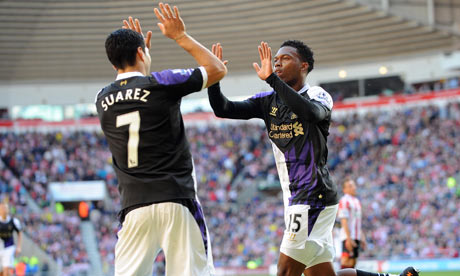The form of Liverpool’s Daniel Sturridge and Luis Suarez has prompted many to pose the question – are the SAS (that abbreviation is terribly tiresome, sorry, I know) the best forward pairing in the league?
The truth is, they probably are.
Why? Well, ask yourself this; is there any real competition?
If you’re classifying a partnership as two “out and out” strikers (although Brendan does like to call them nine-and-a-halves) then the Sturridge-Suarez combo has no real challenger to the forward-duo throne – because most other Premier League sides (as do the majority of top European clubs) play with one primary striker.
There are those that could argue the point for the talents of Manchester United’s Wayne Rooney and Robin Van Persie, yet, the former is deployed as much more of a “number 10” tucked in behind RVP rather than someone alongside.
They are, no doubt, technicalities but the point remains that Sturridge and Suarez’s link-up is somewhat of a rarity in the modern game – which is fairly exceptional when you consider how prominent having two forward players was for most English sides as little as 10 years ago.
Remember the days when fielding a single striker was considered negative?
In the not-so-distant past, having a sole presence at the point of your team usually signalled you were ready to “shut up shop” and soak up pressure.
Nowadays, having an extra body in midfield is more emblematic (great word) of a team that wants to dominate possession of the ball. It does, however, mean that “the one” usually has to be more of a complete striker than beforehand – rather than having two players that could compliment each other’s strengths. Think Emile Heskey and Michael Owen. Or Niall Quinn and Kevin Phillips. Or any other semi-decent little and large double act.
SAS’s (there it is again, sorry) emergence does, however, challenge whether front twos could become fashionable once more. There are examples of other prominent European outfits who play with two strikers – notably the increasingly-formidable Atletico Madrid, Italian champions Juventus and, formatively this season, Manchester City.
However, two of those three have reverted to just the one striker when faced with typically stronger opposition. Atleti were unlucky to lose out to Barcelona in a two-legged Super Cup tie playing with a 4-5-1 (instead using Diego Costa as a wide player) while City elected to use only Sergio Aguero against Chelsea at the weekend – leaving Edin Dzeko and Alvaro Negrado on the bench.
City boss Manuel Pellegrini did use two strikers for the recent visit of Bayern Munich to the Etihad but, ultimately, relinquished territorial dominance in the match – and was subsequently criticised for his decision to use two strikers (who’d have thought, eh?).
For the moment, it suits Liverpool to play with both Sturridge and Suarez. Both are in fine form, consistently scoring goals and are, arguably, Liverpool’s best players (discounting the more reserved role for Steven Gerrard). So finding a position for both of them in their preferred positions makes sense.
It’s also worth remembering that Liverpool aren’t short on central defenders, either. Meaning using three at the back and two upfront is an ideal solution for Rodgers.
Whether Liverpool become exploited further down the line remains to be seen. Their visit to Arsenal this weekend should prove the sternest test of Liverpool’s two-pronged attack to date.
And, even if Liverpool do come away with a positive result, it’s unlikely that they’ll be able to sway the sole-striker trend just yet. For one, not many teams have the capability to play two such talented and prolific goalscorers in their forward line. Arsenal, for instance, would probably (without doubt) be quite resistant to pairing Nicklas Bendtner with Olivier Giroud.
And second, as I touched upon earlier, the modern day centre-forward is so much more than just a goalscorer which offers teams the opportunity to play with extra men in midfield. Throw in the consensus that most managers aren’t overly fond of defending with three at the back and you generally end up with a 4-5(somewhere positioned in between)-and-a-1.
The success of Barcelona and Bayern Munich in recent years are the two highest profile examples of why playing with one striker that can reap huge rewards. That sort of winning blueprint always trickles down the pyramid. And, as such, only until another powerhouse team of European football materialises with two forwards at the helm will we be likely to see duos back in fashion.


